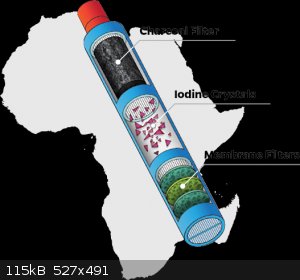RogueRose
International Hazard
    
Posts: 1585
Registered: 16-6-2014
Member Is Offline
|
|
Changing salt water (sea water) drinkable (or less poisonous) by replacement reaction or acid
I was thinking about how sea water can't be drunk unless run through a RO system or boiled and distilled. Both can be next to impossible while
traveling light like hiking (or military missions).
I was wondering what the possiblities would be to adding a compound or acid to the sea water to change the salt to a less harmful substance, one the
could be filtered out or one that could be gassed off by boiling.
I've looked at something like sulfuric acid to change the salt to sodium sulfate but that would leave HCl which I guess might boil off as the
concentration would be pretty low and it might lower the BP (as I've seen in some other reactions).
I'm sure this has been looked into in the years past in the military (well at least they should have I would think).
Is there anything that can be added to precipitate out anything harmful and either allow remaining compounds (if safe) to stay in solution, or boil
them off?
|
|
|
DraconicAcid
International Hazard
    
Posts: 4278
Registered: 1-2-2013
Location: The tiniest college campus ever....
Member Is Offline
Mood: Semi-victorious.
|
|
There are personal-sized reverse osmosis devices.
Please remember: "Filtrate" is not a verb.
Write up your lab reports the way your instructor wants them, not the way your ex-instructor wants them.
|
|
|
zwt
Hazard to Self
 
Posts: 84
Registered: 1-8-2016
Member Is Offline
Mood: No Mood
|
|
There is another technology for producing a potable liquid from seawater, which meets your requirements of being lightweight and simple:
Foward osmosis bag
The catch is that the liquid produced is not pure water, but a Gatorade-like carbohydrate/electrolyte beverage.
Incidentally, I question their claim "...drink any water found on the ground, no matter how contaminated." It seems like the bag would cease to operate if the concentration of soluble
contaminates approached the concentration of the syrup, and even at somewhat lower concentrations of contaminants, the "drinkable" liquid produced
might be too concentrated to hydrate whoever drinks it.
[Edited on 14-2-2017 by zwt]
|
|
|
Amos
International Hazard
    
Posts: 1406
Registered: 25-3-2014
Location: Yes
Member Is Offline
Mood: No
|
|
Even if you were to precipitate the sodium and other ions (which only a very small handful of compounds are able to do), this could only be done by
dumping more ions in, effectively making the process useless.
No acid is going to remove sodium from solution. And any sodium at all at the concentration found in seawater, regardless of the anion, will cause
dehydration after a short time due to the extra water needed by the kidneys to dispose of it. The sulfate ion tends to have a laxative effect, by the
way. So sodium sulfate is likely even worse to be ingesting in those amounts.
| Quote: | | I've looked at something like sulfuric acid to change the salt to sodium sulfate but that would leave HCl which I guess might boil off as the
concentration would be pretty low and it might lower the BP (as I've seen in some other reactions). |
A hydrochloric acid solution with a concentration below that of the azeotrope (20.2%, which you're not going to survive long drinking) will become
more concentrated as it evaporates, since the vapor pressure is lower than that for normal water.
|
|
|
Scalebar
Hazard to Self
 
Posts: 54
Registered: 6-5-2016
Location: Europe!
Member Is Offline
Mood: Looking for a way out
|
|
Quote: Originally posted by zwt  | There is another technology for producing a potable liquid from seawater, which meets your requirements of being lightweight and simple:
Foward osmosis bag
The catch is that the liquid produced is not pure water, but a Gatorade-like carbohydrate/electrolyte beverage.
[Edited on 14-2-2017 by zwt] |
When we demoed them at a science festival we used urine and made damn sure we 1. used our own bags not anyone elses and 2. drank out of the correct
side...
|
|
|
PHILOU Zrealone
International Hazard
    
Posts: 2893
Registered: 20-5-2002
Location: Brussel
Member Is Offline
Mood: Bis-diazo-dinitro-hydroquinonic
|
|
Maybe hydroxy anion exchange resins and proton cation exchange resins may be a solution to scavenge all cations and anions and replace them by water
(H(+) + OH(-)).
Any precipitation reaction will generate worst problem or displace the saline problematic.
There are only a few reactions when precipitation leads to a purer water...but then there must be coprecipitation like BaS and FeSO4 yielding BaSO4
and FeS precipitates...and thus reducing strongly the amount of anions and cations into the water.
Such case will never happen with sodium since most/all of its salts are solubles...so if you precipitate the chloride, you will replace it by
something else... another anion...so no gain.
PH Z (PHILOU Zrealone)
"Physic is all what never works; Chemistry is all what stinks and explodes!"-"Life that deadly disease, sexually transmitted."(W.Allen)
|
|
|
A Halogenated Substance
Hazard to Self
 
Posts: 68
Registered: 7-2-2017
Location: United States
Member Is Offline
Mood: Oxidizing due to extended exposure to oxygen
|
|
This reminds me of a particular straw they are using in areas that have little to no access to fresh water. Perhaps you could inspire a design off of
it?

Ouch. The words are hard to see. But from top to bottom it says "activated charcoal, iodine crystals, and membrane filters".
Here it is in use:

|
|
|
pneumatician
Hazard to Others
  
Posts: 409
Registered: 27-5-2013
Location: Magonia
Member Is Offline
Mood: ■■■■■■■■■■ INRI ■■■■■■■■■■ ** Igne Natura Renovatur Integra **
|
|
asked the military? if you live in the usa, exist a law called "freedom act of info" or something like this.
[Edited on 19-2-2017 by pneumatician]
|
|
|
BromicAcid
International Hazard
    
Posts: 3227
Registered: 13-7-2003
Location: Wisconsin
Member Is Offline
Mood: Rock n' Roll
|
|
PHILOU Zrealone is correct in mentioning ion exchange resins. Theoretically it's easy, a cation exchange resin replaces Na<sup>+</sup>
(and others) with H<sup>+</sup> and an anion exchange resin replaces the Cl<sup>-</sup> with HO<sup>-</sup>,
effectively replacing all cations/anions with water. In practice it can be difficult since the cation exchange resins are themselves acid/basic so
the discharge water ends up skewed in pH and not a perfect 7. I have seen these setups used industrially with banks of exchange resin so they are
practical but I am not sure if they are practical on the small scale.
|
|
|
PHILOU Zrealone
International Hazard
    
Posts: 2893
Registered: 20-5-2002
Location: Brussel
Member Is Offline
Mood: Bis-diazo-dinitro-hydroquinonic
|
|
Quote: Originally posted by BromicAcid  | | PHILOU Zrealone is correct in mentioning ion exchange resins. Theoretically it's easy, a cation exchange resin replaces Na<sup>+</sup>
(and others) with H<sup>+</sup> and an anion exchange resin replaces the Cl<sup>-</sup> with HO<sup>-</sup>,
effectively replacing all cations/anions with water. In practice it can be difficult since the cation exchange resins are themselves acid/basic so
the discharge water ends up skewed in pH and not a perfect 7. I have seen these setups used industrially with banks of exchange resin so they are
practical but I am not sure if they are practical on the small scale. |
 Thank you for pointing this out Thank you for pointing this out 
Also to be noted that it is best that the water is not completely desionized if it has to be used for drinking...so even if process is uncomplete it
is not a bad thing.
About the final pH...if it remains into the range of 6-8 it is physiologically fine (many drink water are into that range depending onto their
origin...some are even outside this but those are special water for cures/special diets).
PH Z (PHILOU Zrealone)
"Physic is all what never works; Chemistry is all what stinks and explodes!"-"Life that deadly disease, sexually transmitted."(W.Allen)
|
|
|
macckone
International Hazard
    
Posts: 2159
Registered: 1-3-2013
Location: Over a mile high
Member Is Offline
Mood: Electrical
|
|
I use a prefilter and reverse osmosis filter when camping.
I also carry iodine and chlorine dioxide tablets.
The prefilter is important for really turbid water.
UV pens will kill most bacteria if prefiltered.
Ps. Military uses prefilter then RO.
The personal kits are a couple of ounces.
[Edited on 21-2-2017 by macckone]
|
|
|
symboom
International Hazard
    
Posts: 1143
Registered: 11-11-2010
Location: Wrongplanet
Member Is Offline
Mood: Doing science while it is still legal since 2010
|
|
Sea water
Adding Silver nitrate to form silver chloride and Sodium nitrate
to the sodium nitrate adding urea citrate to form urea nitrate
Calcium ascorbate to form insoluble calcium sulfate from the magnesium sulfate present in water
The ions left are magnesium ascorbate and sodium citrate both are need when at sea for prevention of scuvy
Would this work as a safe ion removal technique the salts present
|
|
|
A Halogenated Substance
Hazard to Self
 
Posts: 68
Registered: 7-2-2017
Location: United States
Member Is Offline
Mood: Oxidizing due to extended exposure to oxygen
|
|
Doesn't the magnesium ion act as a sort of laxative? I'm not sure if constant laxative use is exactly great for one's bowels...
If you wanted to rid of this, you could try to add an alkali metal hydroxide or carbonate to precipitate out the majority of the magnesium and leave
it as a trace; you would also then be left with sodium absorbate instead.
|
|
|
PHILOU Zrealone
International Hazard
    
Posts: 2893
Registered: 20-5-2002
Location: Brussel
Member Is Offline
Mood: Bis-diazo-dinitro-hydroquinonic
|
|
As exposed above it is only displacing the problem...the water contains too much ions and its osmotic pressure makes it non drinkable in medium to
large amount...
PH Z (PHILOU Zrealone)
"Physic is all what never works; Chemistry is all what stinks and explodes!"-"Life that deadly disease, sexually transmitted."(W.Allen)
|
|
|